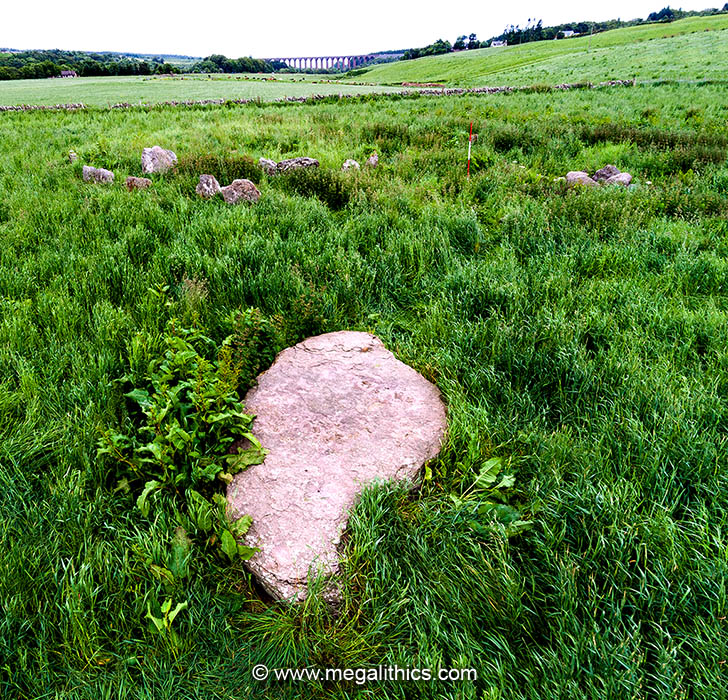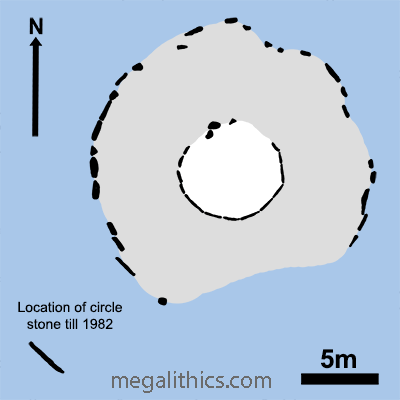 |
| NH 75118 43770 (GPS 45min) Centre. | Diameter 17.8m Outer kerb, Inner kerb 6.0m (meas.) |
| Visited June 2010 | Alt.116m OD (GPS) |
 |
Culdoich. also known as Miltown of Clava South (see later) ( INV 21 ), is a Clava Ring-Cairn in a reasonable state of preservation. The cairn is situated about 3.5km ESE of Culloden on level ground at the bottom of a river valley. The Moray Forth is 5.5km away to the NW but not visible, the river Nairn flows past only 500m to the NW. The area is a Clava monument hot spot with many other cairns (including one recently discovered close by) within just a few kilometres, Miltown of Clava North is only 250m to the NE and the name-defining monuments of Balnuaran of Clava a further 500m NE past that (see map below).

MONUMENT NOMENCLATURE
There is some confusion in the literature regarding the naming of several Clava monuments in the Nairn valley that are in close proximity. The Thoms and Burl (7) refer to the site covered in this page as Miltown of Clava, with Culdoich only listed as asecondary, or alternate name. Also, it is sometimes unclear which sites are described by antiquarian references with various names (if any!). We have adhered to the naming scheme found in Henshall's great work (6), and have produced the following map based on this.

The correct name of this site is Culdoich (INV21), Miltown of Clava is used to describe two sites about 200m away to the NE. Miltown of Clava North (INV43) is a much ruined Clava cairn of undetermined type of which only one large monolith and a few other stone are currently visible. Miltown of Clava South (INV44) is thought to have been a Clava monument, but this was completely destroyed by the building of a chapel on the site, and no trace of the original monument remains.
PUBLISHED ACCOUNTS
Compared to many other Clava monuments, Culdoich is relatively well covered in the early literature. Innes (1) describes "an enormous erect stone, standing at least 12 or 14 feet above the soil, and beside it a cairn as yet undisturbed". He further comments that the natives referred to the site as "Culduich". In 1881, William Jolly (2) included Culdoich in his survey of cup-marked stones in the Inverness region. He found five cup-marks on three stones (for details see the Rock Art and Antiquarian pages). Fraser (3) in 1884 provides a good plan of the site and describes the space between the kerb rings as "partially filled with small stones to a depth of from 2 to 3 feet". So it seems likely that some of the cairn fill had survived to Fraser's time. Piggott (4) excavated much of Culdoich in 1956, producing an excellent plan of the monument. He was delighted to find that the cairn centre was undisturbed and that "the old ground surface was covered by 2—3 ft. of stones and earth". He discovered that the ground of the central space was "heavily impregnated with charcoal and scattered cremated human bones". He comments that the stones of the inner kerb stood 5 feet tall, which is amazing to us, having personally viewed what only manages to peep above the surface today. Piggott does not seem to have been enthralled by his work at Culdoich writing that it was "singularly uninformative, beyond establishing the fact that the cremation burial rite was used".
Almost two kilograms of bone fragments were
recovered by Piggott in his excavation and these were passed to F.P.Lisoski for
analysis
(5),
he concluded that bone was from "one male and one female. One or both belonging
to the middle-age group". He also observed the small size of the bone
fragments and suggested that they may have been broken up after cremation.
Culdoich is, of course, covered in Henshall's 1963 magnum opus
(6)
although the description is brief. The Thoms and
Burl (7)
plan the site in their work of 1980 and provide another brief
description. Culdoich is mentioned extensively throughout Bradley's excellent
modern analysis of the Clava monuments as a class (8)
where he also reports for the first time, the discovery of a neighbouring
monument, Culdoich South. This exciting "new" addition to the Clava catalogue is
thought to be a passage grave.
THE CAIRN STRUCTURE
The cairn is situated on flat land at the bottom of the River Nairn valley, indeed the river runs only 500m away to the NW. Culdoich is a Clava Ring-Cairn and originally had three rings of upright stones. A ring of inner kerb stones encircled a open space of about 6m diameter, around this is the larger ring of the outer kerb stones that we measured at 17.8m and finally, the cairn itself was surrounded by a free standing stone circle. Today, the circle of inner kerb stones survives almost intact, save for disturbance in the northern arc. Around three quarters of the outer kerbs stones exist still standing in their original positions, but the southern arc of these has unfortunately been obliterated by the intrusion of a gravel mine into the cairn structure. All of the kerbs are buried to some extent and it is easy to think of them as small stones, but Piggott found that the inner kerbs were up to 1.5m tall when fully exposed. The most devastated part of the monument, however, is the stone circle of which only one member remains.
The circle stone is massive, we measured it as 4.6m long, 2.6m wide and 0.31m thick. The monolith presently lies prostrate, but it was erect, albeit with a precarious lean, until as late as 1982. Jolly (2) gave its height at 11foot 8inches (3.65m) above ground in 1881 and described finding two cup marks low down on the outer face. This face is currently beneath the fallen stone so we could not photograph this rock art. The stone is tellingly of red sandstone, for some reason the builders of Clava monuments often used red coloured stones in their construction, sometimes in the entirety, and in other examples, to emphasise a particular feature, or direction. The important direction for Clava monuments is nearly always southwest, a directional orientation shared by the Recumbent Stone Circles (RSCs) found exclusively in this region. This not a coincidence, many RSCs have internal ring-cairns, and it is now thought that the original primary monument was the ring-cairn, with the RSC a later modification. In essence, it means that RSCs are all multi-phase monuments.
The space between the inner and outer kerb stones would have originally been filled with thousands of small boulders, these would probably also have been packed some way up the outer surfaces of both kerb rings to prevent the mass of the cairn fill toppling the kerb stones. After visiting many Clava ring-cairns and passage graves we have noticed that in nearly all cases, the large circle stones and the tiny boulders of the cairn fill are always the items robbed away, the kerb stones are rarely removed, except when activity such as mining intrudes. We can only think that this selective robbing is driven by the utility of the items, circle stones split for gateposts, for example, and small boulders being very useful (and transportable) for many purposes. Perhaps the kerbs stones occupy a kind of inverse Goldilocks niche, too big to handle easily, and yet too small to yield useful stones if split.
We did notice what appears to be a large kerb stone standing radially between the inner and outer kerb rings, this stone does not appear on any plan we have seen, nor is it described in any account. It is fully erect and bedded and it resembles the kerbs closely, we can only think that it is a displaced kerb stone that has been re-erected by someone who had no knowledge of the original structure.
In its current buried and overgrown state, there is little that protrudes much above ground. Although the original form of the monument can be made out, with the monolith now fallen there is little to impressive the casual visitor, so we would recommend Culdoich for the inveterate Clava fans only.
1.
Innes, C.,
Proceedings of the Society of Antiquaries of
Scotland, 3, p.48,1857-59.
2. Jolly,
W.,
Proceedings of the Society of Antiquaries of
Scotland, 16, p.321-2,1881-82.
3. Fraser J.,
Proceedings of the Society of Antiquaries of
Scotland, 18, p.338-40,1884.
4.
Piggott, S., Proceedings of the Society of Antiquaries of
Scotland, 88, p.190-2,1956.
5.
Lisoski, F.P.,
Proceedings of the Society of Antiquaries of
Scotland, 89, p.83-90,1955-56.
6.
Henshall, A. S.,
The Chambered Cairns of Scotland,
p.371-3, Edinburgh University Press, 1963,
Edinburgh.
7.
Thom, A., Thom, A. S. and Burl, A., Megalithic
Rings, B.A.R. British Series, 81, p.248-9, 1980, Oxford.
8.
Bradley, R., "The Good Stones, A New Investigation of the
Clava Cairns", Society of Antiquaries of Scotland
Monograph Series Number 17, p177, Edinburgh 2000.